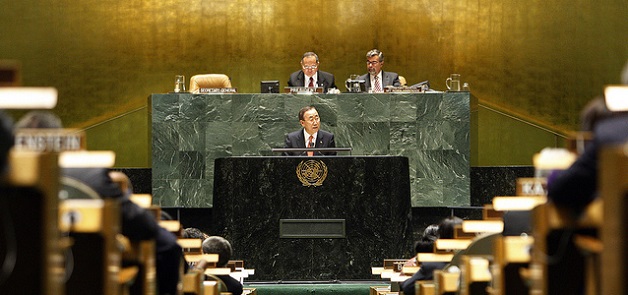The Hollow 2014 NPT PrepCom

Bold steps are needed to shore up the NPT and protect humanity from nuclear calamity.
Last year, an article in the Economist asked: “How did the world become so complacent about nuclear weapons?” The piece was written in response to Eric Schlosser’s astonishing account of the nuclear accidents that occurred in the United States from the 1950s to the 1980s, most of which had been hidden from the public eye. The revelations might have been expected to prompt the international community to face up to and address the very real dangers that nuclear weapons pose, and yet a disturbing attitude of nuclear complacency continues to prevail among those with the greatest responsibility and capacity to act: the nuclear-reliant states. These include:
- the nuclear-weapon states (China, France, Russia, the United Kingdom and United States);
- the nuclear-armed states that are not party to the Nuclear Non-Proliferation Treaty (NPT) (India, Israel, and Pakistan) or have withdrawn (North Korea); and
- states that choose to rely on U.S. nuclear weapons for their security (the members of NATO, plus Australia, Japan and South Korea).
A Lack of Urgency
This behaviour was clearly on display from April 28 to May 9, when disarmament ambassadors and officials from around the world met at the United Nations headquarters in New York for the NPT Preparatory Committee (PrepCom); a UN-hosted conference to discuss and prepare recommendations for the 2015 NPT Review Conference. Although a group of states known as the New Agenda Coalition (Brazil, Egypt, Ireland, Mexico, New Zealand, and South Africa) submitted a proposal urging serious discussion of multilateral disarmament instruments, this was blocked by states that continue to deploy nuclear weapons. In the end the conference failed to make any consensus recommendations on how disarmament, or the related issues of non-proliferation and the peaceful uses of nuclear energy, should be handled at next year’s Review Conference.
This failure was predicted, but it doesn’t augur well for the long-term health of the nuclear non-proliferation regime, despite the efforts of the PrepCom Chair, Peruvian Ambassador Enrique Roman-Morey, to present the outcome as a ‘glass half-full’. He and others remarked on the cheerful mood that prevailed during the meeting despite the events unfolding in Ukraine and elsewhere.. But the diplomatic niceties masked a dark reality; states that agreed to forgo nuclear weapons development in the interests of global safety and security no longer believe the nuclear-reliant states are serious about nuclear disarmament. Even the more moderate among the non-nuclear-weapon states are losing patience as the continuing deterrence doctrines, forward-basing of nuclear weapons and reliance on nuclear umbrellas makes the disarmament rhetoric of many states appear hollow and duplicitous. Moreover, as the New Agenda Coalition observed, while reductions in nuclear weapons are crawling along, nuclear modernisation programmes underway in the nuclear-weapon states amount to a de facto qualitative nuclear arms race. The result, which was visible behind the smiles in New York, is that the trust and confidence on which the NPT depends has worn alarmingly thin.
The Other Side
Many advocates of nuclear deterrence won’t lose much sleep over these developments, because beneath their disarmament rhetoric, they (the Australian government included) regard nuclear weapons as tools of stability, without which the world would be more conflict-prone. Given a choice some political leaders and officials would probably sacrifice the NPT and accept further proliferation rather than end their country’s reliance on nuclear deterrence. But nuclear stability is a dangerous fallacy; proliferation begets more proliferation, which increases the probability of nuclear use, whether by accident or intent. This point was reinforced at the PrepCom during a side-event discussion on nuclear risks; according to a recently published Chatham House study, which examines cases of deliberate rather than accidental ‘near nuclear use’, the world has come perilously close to nuclear use on at least 13 occasions since 1962 and the risks are growing.
The Critical Lynchpin
The NPT is still the best mechanism we have for dealing with these risks, but it can’t continue to be taken for granted if it’s to survive; states need to uphold their treaty commitments or risk losing the critical lynchpin of the nuclear non-proliferation regime. It’s clear that the current situation where some states continue to justify and rely upon nuclear weapons for their security, while preaching that others shouldn’t, isn’t sustainable. At the same time those who focus exclusively on the NPT’s discriminatory nature and argue that the treaty should be abandoned in favour of a more egalitarian prohibition regime need to be realistic; the NPT is deeply flawed but even a limping NPT is sturdier than the proposals for alternative legal mechanisms.. States that haven’t honoured their disarmament obligations under the NPT are highly unlikely to sign up to an alternative framework that they haven’t helped develop. Despite its baggage the NPT needs to be strengthened and supplemented rather than replaced.
That said serious work is urgently needed to develop a credible supplementary framework for multilateral nuclear disarmament. The New Agenda Coalition’s Working Paper made a good start by sketching out some of the challenges involved, including:
- how to ensure that a dedicated disarmament instrument (or instruments) build upon the NPT rather than undermining it;
- how disarmament instruments could be implemented and sustained over time; and
- how the difficult problem of hold-out states could be handled.
But the paper overlooked broader challenges that have a much more significant impact on disarmament momentum, which is the crucial issue of how to create and maintain peace and stability in a world that is prone to deadly conflict. It’s time the nuclear-reliant states, which bear the greatest burden of responsibility for nuclear disarmament and have the capacity to make it happen, worked together to address this question in earnest instead of continuing to fall back on the excuse that the international environment isn’t conducive to nuclear elimination.
The nuclear-weapon states and their allies need to rise to the challenge proposed by the New Agenda Coalition: to use existing forums to seriously engage in discussions on how to create a viable and functioning framework for multilateral disarmament and how to create the political and strategic conditions that would assist in its implementation.
Dr Tanya Ogilvie-White is Research Director and Associate Professor at the Centre for Nuclear Non-Proliferation and Disarmament, Australian National University and Fissile Material Working Group (FMWG) Regional Representative for the Asia-Pacific.





